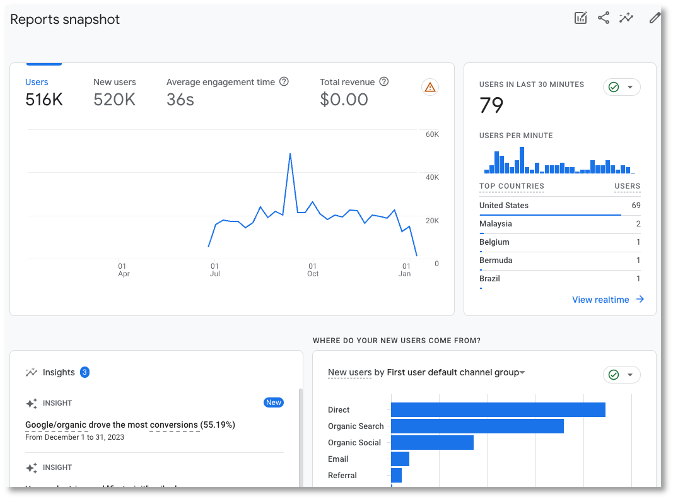In digital strategy, three core areas of focus—Data Privacy, Technical SEO, and Measurement Strategy/Tagging—emerge as indispensable digital initiatives for organizations striving for excellence in 2024. These components enhance a company’s online presence and visibility, ensure compliance, optimize performance, and align with strategic objectives across every organization.
Data Privacy: Digital Trust and Compliance
Understanding Data Privacy
Data Privacy revolves around the responsible handling of personal data, including its collection, storage, and usage. Key aspects of data privacy involve implementing and auditing cookie policies with tools like Iubenda and OneTrust, adhering to regulations such as GDPR and California privacy laws, and navigating the intricacies of cookie databases and categorizing those cookies and trackers.
Practical Applications
Audits of tools and cookie policies within organizations are critical. These involve the legal categorization of cookies and trackers and fixing inaccuracies to ensure compliance and avoid penalties. The implementation process involves practical steps to ensure that organizations use the information to categorize pixels legally and implement them correctly across their digital platforms.
The Importance of Data Privacy
Given the varied privacy laws across regions, organizations must prioritize compliance to avoid legal repercussions and maintain consumer trust. Understanding the geographical location of operations and the associated legal requirements is crucial in this context.
Commonly Asked Questions Regarding Data Privacy:
What is Data Privacy in a Digital Context?
Data privacy involves the transparent management of personal data online, focusing on collection, storage, and usage, ensuring compliance with laws like GDPR and other regional regulations.
Why is a Cookie Policy Important for a Website?
A cookie policy helps in transparent data management, aligning with legal requirements, and building user trust.
How Do Tools Like Iubenda and OneTrust Help in Data Privacy?
Tools like Iubenda and OneTrust automate the process of categorizing and managing cookies and trackers, aiding in compliance with privacy laws.
What Are the Consequences of Non-Compliance with GDPR and Other Privacy Laws? Businesses and corporations can face legal fines, experience damage to the organizations reputation, and potentially lose customer trust.
Technical SEO: Online Visibility and User Experience
Exploring Technical SEO
Technical SEO is a specialized area focusing on a website’s technical elements to enhance its visibility in search engine results. This includes pinpointing factors that negatively impact overall site health, content, internal links, site speed, and URL structure, and it addresses issues such as 4xx errors and website security.

Case Studies and Success Stories
Notable work includes comprehensive SEO audits, like the one RBA conducted for one of our large, global clients. With these audits, we utilize a combination of tools like SEMRush and Moz to identify issues affecting site speed, structure, and indexing. This approach is vital for laying a foundation for effective SEO strategies. In these audits, RBA also provides steps for remedial actions to rectify these issues.
Recognizing the Need for Technical SEO
Key indicators necessitating technical SEO include changes in data patterns, such as drops in organic traffic, losing search engine rankings, recent website redesigns, or platform migrations. Addressing these indicators promptly ensures sustained search engine visibility and an optimal user experience.
Commonly Asked Questions Regarding Technical SEO:
What is Technical SEO, and Why is it Important?
Technical Search Engine Optimization (SEO) refers to the auditing and optimization of a website’s technical aspects to improve search engine rankings, visibility and user experience.
How Does Site Speed Impact SEO and User Experience?
Websites with healthy technical factors rank better due to better performance and enhanced visibility on search engines and offer a better user experience.
What are Common Issues Found in a Technical SEO Audit?
Issues often include overall site health, title tags and meta description issues, content errors, broken/faulty internal links, site speed issues, URL structure errors, indexing and crawling problems, 4xx errors, website security or certificate issues, schema markup complexities, and redirect mistakes.
How Often Should a Website Undergo a Technical SEO Audit?
Ideally, a website should have an audit annually or after major updates and/or platform changes.
What Tools are Recommended for Technical SEO Analysis? Tools like SEMRush, Moz, and Google Search Console are commonly recommended for technical SEO audits.
Measurement Strategy: Alignment with Business Goals and Objectives
Overview of Measurement Strategy and Tagging
This strategy involves aligning business objectives with user engagement analytics. It includes defining specific goals, identifying important user interactions, and understanding their correlation with the broader business strategies. Through Google Tag Manager, Tagging plays a crucial role in tracking these interactions so the business can accumulate more granular and unique user data.
Highlighting Significant Projects
We recently worked with a large university in the US. where an initial in-depth engagement with stakeholders led to a comprehensive understanding of data usage needs. The transition to Google Analytics 4 (GA4) and the strategic deployment of tags within different segments within the university and across digital properties exemplify the practical application of these strategies.

Identifying the Need for Measurement Strategy
Organizations needing clear engagement goals, experiencing inconsistent user interaction data, struggling with tracking conversion metrics, or requiring tailored data insights stand to benefit immensely from a thoughtfully curated measurement strategy and tagging initiative.
Commonly Asked Questions Regarding Measurement Strategy/Tagging:
What is a Measurement Strategy in Digital Marketing?
It aligns data collection and analysis with organizational objectives, focusing on tracking user engagement and conversions.
How Does Tagging Work in Conjunction with Google Analytics?
Tagging tracks specific user actions and sends this data to Google Analytics for detailed analysis.
What are the Benefits of Using Google Tag Manager?
It simplifies tag management, improves site speed, and allows for more precise data collection.
How Can Organizations Define Effective Engagement Goals?
By analyzing their target audience, objectives, and industry benchmarks to set measurable and relevant goals.
What are the Signs That an Organization Needs to Improve Its Measurement Strategy?
Indicators include unclear data on user interaction, poor conversion rates, and misalignment with organizational goals.
In Closing
Integrating Data Privacy, Technical SEO, and Measurement Strategy forms a triad essential for any business looking to enhance its digital footprint. These elements facilitate compliance, improve visibility, and ensure digital strategies align with the overarching organizational objectives. In today’s digital age, mastering these elements of digital strategy is not just an option but a necessity for organizations aiming to thrive and stay competitive.


Sounds thoughts.